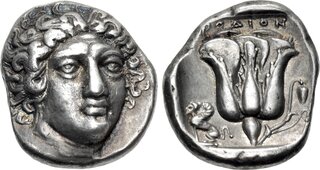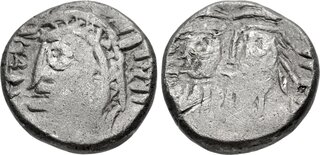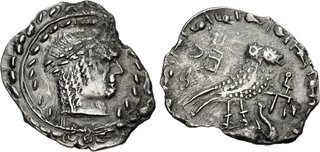Lot description:
ISLANDS off CARIA, Rhodos. Rhodes. Circa 408/7-404 BC. AR Tetradrachm (22.5mm, 15.35 g, 12h). Head of Helios facing slightly right / Rose in profile, with bud to right; POΔION above; to left, sphinx seated left; all within incuse square. Hecatomnus 35a (A23/P30) = Bérend, Tétradrachmes 28 (this coin, illustrated in Bérend); Ashton 4; SNG Keckman –; Karl –; SNG von Aulock –; SNG Copenhagen –; BMC 11; HGC 6, 1417. Iridescent tone, traces of die rust. Good VF. Well centered and in high relief. Very rare issue, one of only 16 examples noted by Ashton (in Hecatomnus).
Ex Peus 401 (3 November 2010), lot 388; Triton VIII (11 January 2005), lot 477; Leu 72 (12 May 1998), lot 275; Numismatica Ars Classica 9 (16 April 1996), lot 344; 1971 Marmaris Hoard (IGCH 1209).
The polis of Rhodes was created out of a synoecism of the cities of Ialysos, Kamiros, and Lindos in 408/7 BC, and immediately began to issue a series of coinage that endured until the Roman era. The rose was chosen as the perennial reverse type, a punning allusion to the city's name. The obverse type was usually the head of Helios, the patron deity of the new polis, but occasionally the nymph Rhodos appeared. Until the end of the Rhodian series, these types adorned the coins, with a few exceptional issues that featured novel designs. The Chian standard was employed, although after a reduction in the late 340s, the standard is commonly called 'Rhodian.' The first issue of Rhodian coinage was a brief, yet large issue of tetradrachms, that stand among the finest pieces of Classical Greek art. On the obverse, the head of Helios is displayed in a nearly frontal position. Such facing head coins were not novel by this time, but the boldness of the design and the particularly high relief of the dies sets the Rhodian coinage apart from all others. Moreover, this facing head type was the standard obverse type for most of the Rhodian issues. The tetradrachm was the primary denomination until the later 4th century, when the didrachm became preeminent. Both of these denominations were supplemented by a wide variety of fractions, in both silver and bronze, and the tetradrachm was also issued on occasion after the 4th century. Around 190 BC, the coinage system was completely reorganized, with the primary denomination being the drachm, struck on a standard called 'plinthophoric' for the square incuse around the reverse type (plinthos = brick or ingot). Gold coinage was issued on only very rare occasions, and not until the 2nd century BC. As noted by Ashton, the coinage was issued fairly regularly, with occasional spikes in production that correlate to either construction work (e.g. the building of the Colossus) or military necessity. As a primary trading center in the Mediterranean, it is not surprising that the bulk of the coinage of Rhodes appears to have been used for regular state expenditure, such as maintaining its fleet, paying mercenaries, making contributions to the Nesiotic League (revived by Rhodes circa 200 BC), paying state officials, and maintaining a system that cared for its needy citizens (Ashton, pp. 96-7). The massive amount of coinage struck by Rhodes is evidenced by the adoption of the Rhodian weight standard by many other cities in the Hellenistic period, as well as the large amounts of Rhodian coins found in hoards today.
Estimate: 5000 USD |  |









